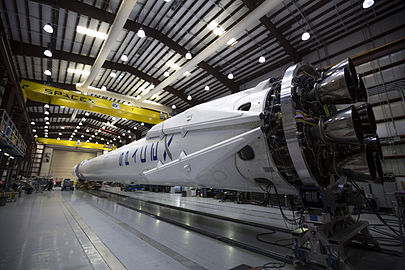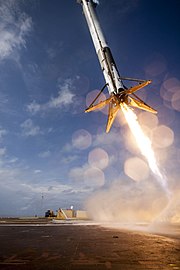SpaceX CRS-6
 The SpaceX CRS-6 Dragon spacecraft as seen from the ISS on 17 April 2015 | |
| Names | SpX-6 |
|---|---|
| Mission type | ISS resupply |
| Operator | SpaceX / NASA |
| COSPAR ID | 2015-021A |
| SATCAT no. | 40588 |
| Website | https://www.spacex.com/ |
| Mission duration | 30 days (planned) 36 days, 20 hours, 31 minutes (achieved) |
| Spacecraft properties | |
| Spacecraft | Dragon C108 |
| Spacecraft type | Dragon CRS |
| Manufacturer | SpaceX |
| Launch mass | 6,000 kg (13,000 lb) |
| Dimensions | 8.1 m (27 ft) (height) 4 m (13 ft) (diameter) |
| Start of mission | |
| Launch date | 14 April 2015, 20:10:41 UTC |
| Rocket | Falcon 9 v1.1 |
| Launch site | Cape Canaveral, SLC-40 |
| Contractor | SpaceX |
| End of mission | |
| Disposal | Recovered |
| Landing date | 21 May 2015, 16:42 UTC |
| Landing site | Pacific Ocean |
| Orbital parameters | |
| Reference system | Geocentric orbit[1] |
| Regime | Low Earth orbit |
| Inclination | 51.65° |
| Berthing at ISS | |
| Berthing port | Harmony nadir |
| RMS capture | 17 April 2015, 10:55 UTC |
| Berthing date | 17 April 2015, 13:29 UTC |
| Unberthing date | 21 May 2015, 09:29 UTC |
| RMS release | 21 May 2015, 11:04 UTC |
| Time berthed | 33 days, 20 hours |
| Cargo | |
| Mass | 2,015 kg (4,442 lb) [2] |
| Pressurised | 2,015 kg (4,442 lb) |
 NASA SpX-6 mission patch | |
SpaceX CRS-6, also known as SpX-6, was a Commercial Resupply Service mission to the International Space Station, contracted to NASA. It was the eighth flight for SpaceX's uncrewed Dragon cargo spacecraft and the sixth SpaceX operational mission contracted to NASA under a Commercial Resupply Services contract. It was docked to the International Space Station from 17 April to 21 May 2015.
Launch history
In July 2014, the launch was scheduled by NASA for February 2015, with berthing to the station occurring two days later. However, as a result of delays in the launch of the previous SpaceX CRS-5 mission, SpaceX CRS-6 launched on 14 April 2015. In late March, 2015, the launch was scheduled for 13 April 2015,[3] but was later postponed to 14 April 2015 due to weather conditions.[4]
A
Payload
Primary payload
NASA has contracted for the CRS-6 mission from SpaceX and therefore determines the primary payload, date/time of launch, and orbital parameters for the Dragon space capsule. The Dragon spacecraft was filled with 2,015 kg (4,442 lb) of supplies and payloads, including critical materials to directly support about 40 of the more than 250 science and research investigations that will occur during Expedition 43 and Expedition 44.[2]
Among other items on board:
- Arkyd series of spacecraft. This is the second Arkyd 3 satellite; in October 2014, the first Arkyd 3 satellite was destroyed on launch in the explosion of the Orbital Sciences Corporation Antares launch vehicle carrying it aboard the third Cygnus cargo resupply flight to the ISS.[7][8]
- satellites for later deployment from the space station via an agreement with Nanoracks, operator of the Center for the Advancement of Science in Space (CASIS).[9]
Secondary payload
SpaceX has the primary control over manifesting, scheduling and loading secondary payloads. However, there are certain restrictions included in their contract with NASA that preclude specified hazards on the secondary payloads, and also require contract-specified probabilities of success and safety margins for any SpaceX reboosts of the secondary satellites once the Falcon 9 second stage has achieved its initial low Earth orbit (LEO).
SpaceX CRS-6 included science payloads for studying new ways to possibly counteract the microgravity-induced cell damage seen during spaceflight, the effects of microgravity on the most common cells in bones, gather new insight that could lead to treatments for osteoporosis and muscle wasting conditions, continue studies into astronaut vision changes and test a new material that could one day be used as a synthetic muscle for robotics explorers of the future. Also making the trip was a new espresso machine for space station crews.[2]
A part of this payload includes science experiments from high schools, such as a project from
Return payload
Dragon returned 1,370 kg (3,020 lb) of cargo to Earth.[2]
Post-launch flight test
After the
This was SpaceX's second attempt to land the booster on a floating platform after an
On 15 April 2015, SpaceX released a video of the terminal phase of the descent, the landing, the tip over, and a small deflagration as the stage broke up on the deck of the ASDS.[14]
Capsule reflight
The Dragon capsule used for this mission was successfully flown a second time in December 2017 with SpaceX CRS-13. The capsule made its third and final flight as part of the SpaceX CRS-18 mission on 25 July 2019.
Gallery
See also
- List of Falcon 9 launches
References
- ^ "DRAGON CRS-6". N2YO.com. Retrieved 31 May 2021.
- ^ a b c d "SpaceX CRS-6 Sixth Commercial Resupply Services Flight to the International Space Station" (PDF). NASA. April 2015. Retrieved 31 May 2021.
 This article incorporates text from this source, which is in the public domain.
This article incorporates text from this source, which is in the public domain.
- ^ "Launch Schedule". Retrieved 4 April 2015.
- ^ Lawler, Richard. "SpaceX's next try at landing a reusable rocket is minutes away". Engadget. Retrieved 13 April 2015.
- ^ "OET Special Temporary Authority Report". Retrieved 4 April 2015.
 This article incorporates text from this source, which is in the public domain.
This article incorporates text from this source, which is in the public domain.
- ^ "ARKYD: A Space Telescope for Everyone". KickStarter. 26 May 2016. Retrieved 31 May 2021.
- ^ Wilhelm, Steve (16 October 2014). "First step toward asteroid mining: Planetary Resources set to launch test satellite". Puget Sound Business Journal. Retrieved 19 October 2014.
- ^ "Antares 130 debut with fourth Cygnus ready for second attempt". NASASpaceFlight.com. 27 October 2014. Retrieved 31 May 2021.
- ^ a b Graham, William (13 April 2015). "SpaceX Falcon 9 scrubs CRS-6 Dragon launch due to weather". NASASpaceFlight.com. Retrieved 14 April 2015.
- ^ "Nanoracks-Ambassador High School-Pollen Propulsion in a Microgravity Environment (Nanoracks-AHS-Pollen Propulsion)". NASA. 3 April 2015. Retrieved 6 April 2015.
 This article incorporates text from this source, which is in the public domain.
This article incorporates text from this source, which is in the public domain.
- ^ "CRS-6 First Stage Landing". YouTube. Retrieved 16 April 2015.
- ^ "Elon Musk on Twitter". Twitter. Archived from the original on 15 April 2015. Retrieved 14 April 2015.
- ^ Bergin, Chris (3 April 2015). "SpaceX preparing for a busy season of missions and test milestones". NASASpaceFlight.com. Retrieved 4 April 2015.
- ^ CRS-6 First Stage Landing SpaceX, 15 April 2015
External links
- NASA
- SpaceX/NASA CRS-6 press kit April 2015








